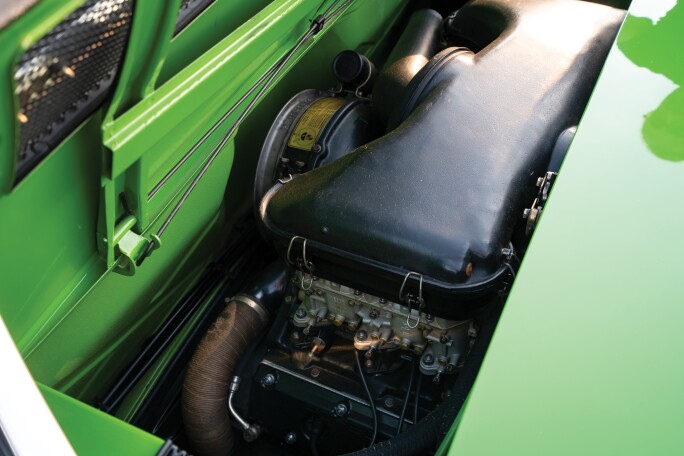T here is no better time to brush up on Porsche lingo than with RM Sotheby’s: The Porsche 70th Anniversary Sale (27 October | Atlanta). The world-renowned German sports car manufacturer might be the most mispronounced marque of all time. Fed up with people saying their name incorrectly, the team at Porsche made a 15-second YouTube video on “How to Pronounce Porsche.” Now that you know how to say it properly, let’s see how much of a Porsche expert you really are.
AIR-COOLED
Considered the “purest” iteration of the 911, all 911s had air-cooled engines from 1963 until the introduction of the 996 in 1999.
CARRERA
Carrera is a Spanish word meaning “race.” Porsche started using the name on the 356 series as an homage to Carrera Panamericana, a border-to-border race held in Mexico from 1950 to 1954.
DUCKTAIL
Although the ducktail has only officially appeared on a handful of Porsche cars, it is as iconic as the 911 itself. The Porsche ducktail spoiler, or ducktail wing, first appeared in the historic Porsche 911 Carrera RS 2.7 in 1973. In true German fashion, it was born out of function rather than form.
FLACHBAU
Porsche offered a Flachbau (“Flatnose” or “Slantnose”) 930 under the Sonderwunschprogramm (Special Order Program) beginning in 1981, an otherwise normal 930 with a 935-style slantnose instead of the normal 911 front end.
FLAT-SIX ENGINE
Porsche is the most prominent manufacturer of flat-six engine luxury sports cars. A flat-six, or a horizontally opposed-six, is a flat engine with six cylinders arranged horizontally in two banks of three cylinders on each side of a central crankcase.
GT2
Starting with the 993 generation, GT2s are the most powerful breed of 911. Focusing on extracting as much power from the engine while shedding as much unnecessary weight as possible, these cars quickly gained a reputation for being frighteningly fast.
GT3
Introduced for the 996 generation, the 911 GT3 was conceived to allow the 911 to compete in the FIA’s GT3 class. These, and their more radical GT3 RS cousins, have quickly become the most desirable variants of the current 911 family tree.
LUFTGEKÜHLT
The direct translation of “air-cooled.” The air-cooled 911 is the most desirable 911 ever made. The engines were air-cooled until the introduction of the Type 996 in 1998, with Porsche’s 993 series, produced in model years 1994–1998, being the last of the air-cooled Porsches.
MACAN
Macan means “Tiger” in both Indonesian and Malaysian. Macan is the final name for the smaller SUV, originally rumored to be the “Cajun.”
PCCB
Porsche Ceramic Composite Brakes. These can be fitted as options to most 911s, Caymans, and Boxsters to replace the standard steel rotors. It is standard on only the top-shelf models, like the 911 Turbo S.
PDK
Porsche Doppelkupplung. A seven-speed transmission with an automatic and a manual selection mode.
PTS
Paint to Sample, or “PTS,” refers to any out-of-range color used on a modern Porsche and is considered to be one of the most desirable options on a collectible 911, almost regardless of color.
RS
RS stands for Rennsport, German for “Racing.” The first car to bear the letters was the 1973 911 Carrera RS. As Carrera means “Racing” in Spanish and Rennsport means “Racing” in German, the 1973 car can be called the 911 Racing (Carrera) Racing (Rennsport) in English.
SC
SC stands for “Super C.” SC was the final version of the 356 C; what it means for the 911 is sort of unclear. Some think it means “Super Carrera,” but this surely isn’t true, as the pre-1978 911 Carreras were more powerful than the 911 SC introduced for 1978. We believe the 911 SC was meant to be the final evolution of the 911, as was the SC for the 356. The 928, which was created to replace the 911, did not succeed in that task, and so the 911 SC was not the last 911 as initially planned.
SPORTOMATIC
Sportomatic was a manual gearbox that used an automatic clutch function and therefore did not have a clutch pedal. For smooth take-offs, the unit was equipped with the hydraulic torque converter used in automatic gearboxes.
WHALE TAIL
The 930 would switch to the “tea tray” design in 1984 as part of the 3.3-liter upgrade. With its upturned edges, the new spoiler was designed to accommodate the intercooler for the updated forced-induction flat-six. The tea tray wing would continue on the 911 Turbo throughout the 964-generation courtesy of the 964 Turbo 3.3 and 3.6, although the Porsche 964 Turbo S would revert to the whale tail style seen in the ’70s.
WATER-COOLED
911s built from the 996 generation onwards with engines cooled by water.

















